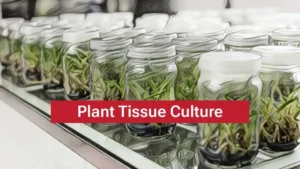
Why in news?
- In a bid to preserve rare native trees and combat challenges to regeneration, the Delhi forest department has embarked on an innovative initiative – the establishment of a tissue culture laboratory at the Asola Bhatti Wildlife Sanctuary.
- This move marks a significant step towards conservation efforts in the region, leveraging cutting-edge technology to safeguard biodiversity and restore ecological balance.
What is the Tissue Culture Laboratory
- At the heart of this initiative lies the tissue culture laboratory, poised to revolutionize the way we approach conservation.
- Through the extraction of plant tissue from fully grown specimens, this laboratory offers a beacon of hope for endangered native Delhi trees.
- By harnessing the power of in-vitro techniques, multiple trees can be generated from a single parent plant, thereby amplifying conservation efforts manifold.
Collaboration with Leading Experts:
- The success of this endeavor hinges upon collaboration with esteemed botanists and scientists from renowned institutions such as the Indian Council of Forestry Research and Education (ICFRE) and the Forest Research Institute (FRI).
- Their expertise and guidance will ensure that the tissue culture laboratory operates at the forefront of conservation science, employing best practices and methodologies.
A Glimpse into Similar Initiatives:
- While the establishment of the tissue culture laboratory at Asola Bhatti Wildlife Sanctuary is a pioneering endeavor, it finds resonance with existing initiatives such as the National Facility for Plant Tissue Culture Repository (NFPTCR).
- Since its inception in 1986, the NFPTCR has been at the forefront of tissue culture research, focusing on a diverse array of plant types ranging from tubers and bulbs to medicinal and aromatic plants.
Applications and Success Stories:
- The potential applications of tissue culture in conservation are boundless.
- From regenerating ridge species to culturing endangered medicinal plants, the benefits are manifold.
- Moreover, the success stories of tissue culture in agriculture underscore its efficacy, with crops like bananas, apples, and pomegranates experiencing higher yields compared to traditional farming methods.
Addressing Concerns:
- However, amidst the optimism surrounding tissue culture, concerns have been raised by biodiversity experts.
- The risk of genetic homogeneity and vulnerability to specific diseases looms large, underscoring the need for caution.
- To mitigate these risks, experts advocate for diversifying parent seeds or seed varieties, thereby preserving genetic diversity and resilience.
The Promise of Conservation:
- In the verdant expanse of Asola Bhatti Wildlife Sanctuary, the tissue culture laboratory stands as a testament to our commitment to conservation.
- As we navigate the intricate web of ecological challenges, this initiative offers a ray of hope for the future.
- Through concerted efforts and unwavering dedication, we can ensure that the rich tapestry of biodiversity thrives for generations to come.
Conclusion
- The establishment of the tissue culture laboratory heralds a new chapter in conservation, blending innovation with tradition to safeguard our natural heritage.
- As we tread this path towards sustainability, let us embrace the transformative potential of technology in nurturing a greener, more resilient planet.
People also ask
Q1: What is a tissue culture laboratory?
Ans: A tissue culture laboratory is a facility equipped to extract plant tissue from fully grown specimens and grow multiple trees from the same plant in a controlled environment.
Q2: What is the primary goal of the tissue culture laboratory at Asola Bhatti Wildlife Sanctuary?
Ans: The primary goal is to conserve rare native trees by growing endangered species in a controlled environment and regenerating saplings of species facing challenges due to invasive species.
Q3: How does tissue culture help in conservation efforts?
Ans: Tissue culture allows for the rapid propagation of plants, enabling the generation of multiple trees from a single parent plant. This method aids in the conservation of endangered species and enhances efforts to regenerate vegetation.
Q4: Who is involved in the establishment of the tissue culture laboratory at Asola Bhatti Wildlife Sanctuary?
Ans: The Delhi forest department is leading the initiative, with assistance from botanists and scientists from the Indian Council of Forestry Research and Education (ICFRE) and the Forest Research Institute (FRI).
Q5: Are there similar initiatives to the tissue culture laboratory at Asola Bhatti Wildlife Sanctuary?
Ans: Yes, the National Facility for Plant Tissue Culture Repository (NFPTCR) in Delhi, established in 1986, is one such initiative. It conducts tissue culture experiments and research on various plant types.
Thank you for your sharing. I am worried that I lack creative ideas. It is your article that makes me full of hope. Thank you. But, I have a question, can you help me?
Your article helped me a lot, is there any more related content? Thanks!
You reported that adequately.
casino en ligne
With thanks, Quite a lot of postings.
casino en ligne
Whoa a lot of valuable data!
casino en ligne francais
Beneficial advice Cheers!
casino en ligne
Thank you, A good amount of knowledge!
casino en ligne fiable
Truly tons of wonderful knowledge.
casino en ligne
You’ve made your point pretty effectively!.
casino en ligne francais
With thanks! An abundance of material!
casino en ligne
Thank you! Lots of forum posts!
casino en ligne francais
You actually reported it really well!
casino en ligne France